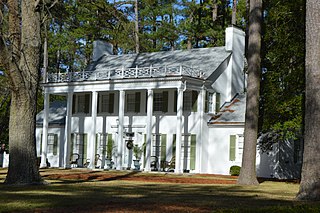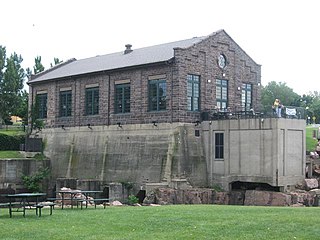
Rocky Mount is a city in Edgecombe and Nash counties in the U.S. state of North Carolina. The city's population was 54,341 as of the 2020 census, making it the 20th-most populous city in North Carolina at the time. The city is 45 mi (72 km) east of Raleigh, the state capital.

This is a list of structures, sites, districts, and objects on the National Register of Historic Places in North Carolina:

Egg Rock Light is a lighthouse on Frenchman Bay, Maine. Built in 1875, it is one of coastal Maine's architecturally unique lighthouses, with a square tower projecting through the square keeper's house. Located on Egg Rock, midway between Mount Desert Island and the Schoodic Peninsula, it is an active aid to navigation, flashing red every 40 seconds. The light was listed on the National Register of Historic Places as Egg Rock Light Station in 1988.

Great Duck Island Light is a lighthouse on Great Duck Island in the town of Frenchboro, Maine, USA. Established in 1890, the light marks the approach to Blue Hill Bay and the southern approaches to Mount Desert Island on the central coast of Maine. The light was listed on the National Register of Historic Places as Great Duck Island Light Station on March 14, 1988. The light is an active aid to navigation maintained by the United States Coast Guard; the property is owned by the College of the Atlantic, which operates a research station there.

First Congregational Church is a historic Congregational church located in Mount Pleasant, Cabarrus County, North Carolina. It was built between 1918 and 1921, and consists of a one-story side gable nave; a two-stage tower; a small, gabled-roof wing that is commonly referred to as the "serving room;" and two concrete additions. The church features stone sheathing and Gothic Revival style design details. The church served the African-American community of Mount Pleasant.

Center Street A.M.E. Zion Church is a historic African Methodist Episcopal Zion church located on S. Center Street in Statesville, Iredell County, North Carolina. It was built in 1903, and is a one-story, three bay by seven bay, Late Gothic Revival style brick building. It has a steep gable roof sheathed in pressed tin and features two corner entrance towers of unequal height and a large, pointed arch stained glass window. The church also goes by the name Mount Pleasant AME Zion Church.

Trinity Episcopal Church is a historic Episcopal church located in Mount Airy, Surry County, North Carolina. It was built in 1896, and is a one-story, Gothic Revival style masonry structure of uncoarsed granite rubble. The main block of the church measures 20 feet by 50 feet. It has a small gable narthex and features lancet windows. It is the oldest church building in Mount Airy.

Joseph Florence Leitner was an American architect whose work includes several rail stations. In Columbia, South Carolina he worked for Charles Coker Wilson for five years. Later he partnered with William J. Wilkins (architect), first in Florence, South Carolina and then in an office in Wilmington, North Carolina, where Leitner practiced for a decade. to form Leitner & Wilkins. His work included commercial, educational, fraternal religious, industrial, residential, and transportation buildings in colonial revival architecture, Flemish architecture (especially gables, Italianate architecture and Romanesque revival architecture styles. He ended his career in Florida.

The William R. Davie House, on Norman St. in Halifax, Halifax County, North Carolina, is a historic house with significance dating from 1783. William R. Davie (1754–1820) was born in England. He was a Founding Father of the United States and a patriot officer of mounted troops in the American Revolution who attended the Constitutional Convention from North Carolina, served as governor of North Carolina, served as a special ambassador to France during the XYZ Affair, and served in the North Carolina legislature. The house, also known as Loretta, was built on five acres that Davie bought in 1783. It was built starting probably in about 1785. It is a large two-story, frame side-hall plan house beneath a gable roof. It has a two-story wing raised from an earlier one-story wing and a number of one-story rear additions. The house is sheathed in weatherboard and rests on a brick foundation.

Greenville Gas and Electric Light Company, also known as Duke Power Steam Plant, is a historic power plant located at Greenville, South Carolina. The two brick vernacular Victorian style buildings were built about 1890. The larger building served as a coal-fueled, steam-powered electric generating plant, and is a one-story, rectangular building with round arched window and door openings. The second building is a two-story rectangular building originally used as offices for the power company. They were originally owned and operated by the Greenville Gas and Electric Light and Power Company, then sold in 1910, to a company that later evolved into Duke Power Company.

North Carolina Electrical Power Company Electric Generating Plant, also known as Elk Mountain Steam Generating Plant, is a historic power station located at Woodfin, Buncombe County, North Carolina. It was built in 1916, and is a tall one-story, rectangular brick and concrete building. It measures 78 feet wide and 165 feet long. It features a 250 foot tall original brick smokestack.

Rocky Mount Central City Historic District is a national historic district located at Rocky Mount, Edgecombe County and Nash County, North Carolina. The district encompasses 166 contributing buildings in central Rocky Mount. It includes a variety of industrial, commercial, residential, and institutional buildings dating from the late-19th through mid-20th centuries. Notable buildings include the Firestation No. 2 (1924), Union Bus Station (1951), the Railway Express Agency Building, Memorial Hospital (1937), Church of the Good Shepherd (1877), Atlantic Coastline Railroad Station (1903-1916), Imperial Tobacco Company Processing Plant (1903-1923), S. H. Kress and Company, Belk-Tyler, Grand Theater, Manhattan Theater, Holy Hope Episcopal Church (1910s), and Summerlin House (1895).
Jones–Wright House, also known as the Polly Wright House, is a historic plantation house located near Rocky Ford, Franklin County, North Carolina. It was built about 1790, and is a two-story, three bay, single pile Late Georgian style heavy timber frame dwelling. It has a low gable roof and brick end chimneys.

West Haven Historic District is a national historic district located at Rocky Mount, Nash County, North Carolina. It encompasses 181 contributing buildings and 2 contributing sites in a residential section of Rocky Mount. The buildings primarily date between about 1928 and 1952, and include notable examples of Renaissance Revival, Tudor Revival, Colonial Revival, and Classical Revival style residential architecture. Notable buildings include the Robert D. Gorham residence (1928), H. Alex Easley House (1934), Leon Epstein house (1928), and Thomas Pearsall House (1933).

Rocky Mount Mills Village Historic District is a national historic district located at Rocky Mount, Nash County, North Carolina. It encompasses 101 contributing buildings and 2 contributing structures in a historic mill village located at Rocky Mount. The buildings primarily date between about 1835 and 1948, and include notable examples of Greek Revival and Bungalow / American Craftsman style residential architecture. The district includes the buildings previously listed as Rocky Mount Mills and includes the Colonel Benjamin D. Battle House (1835). Other notable buildings include the mill village community house (1918) and a variety of one- and two-story frame mill worker houses.

Narrows Dam and Power Plant Complex is a national historic district located at Badin, Stanly County, North Carolina. The district encompasses one contributing building and two contributing structures in the company town of Badin. The dam and power plant were built in 1917 by Alcoa to support the Badin plant. At the time of its completion, the Narrows Dam was the world's highest overflow type dam. The Narrows power plant is a one-story building nine bays wide with a gable roof and six-foot raised monitor roof.

Raleigh Electric Company Power House, also known as the Carolina Power and Light Power House, is a historic power station located at Raleigh, North Carolina. It was built in 1910, and is a triparte, gable-front steel framed common bond brick building. It consists of two original two-story blocks and a one-story replacement block built in 1930. It was originally built to power Raleigh's electric street car system.

Southerland-Burnette House is a historic home in the Mount Olive Historic District in Mount Olive, Wayne County, North Carolina. It was built about 1874 and extensively altered in 1924 in the Classical Revival style. It is a two-story, three-bay, frame dwelling with a gable roof. The front facade features a two-story tetra-style portico with Tuscan order columns.
Thomas J. Pearsall (1903-1981) was an American attorney, politician and philanthropist from North Carolina. He served in the North Carolina House of Representatives and the North Carolina Senate. He was the main instigator of the Pearsall Plan.

The Sioux Falls Light and Power Hydro Electric Plant, formerly the Northern States Power Building, is a historic building in Falls Park in Sioux Falls, South Dakota. Originally built as a hydroelectric power plant on the Big Sioux River, it now houses the Falls Overlook Cafe. It was listed on the National Register of Historic Places in 1993.






















